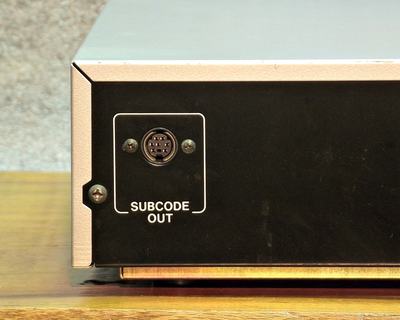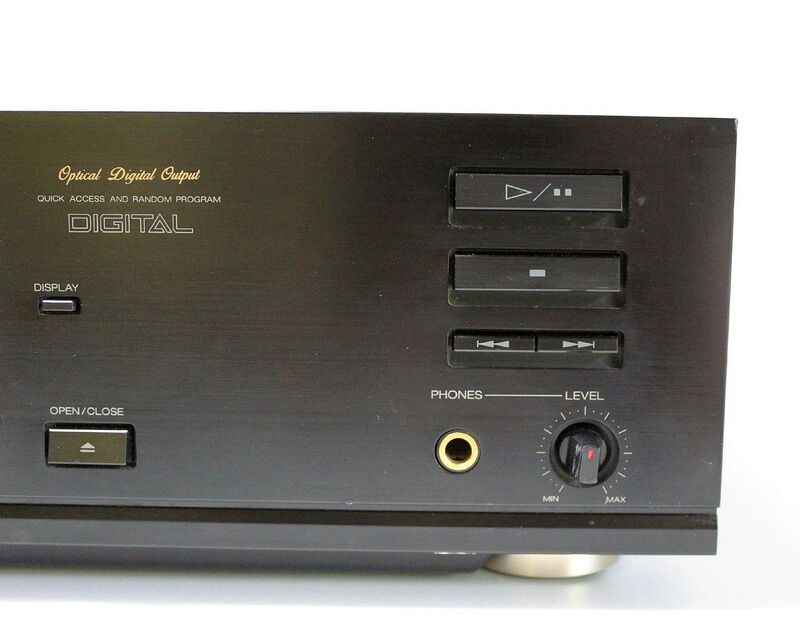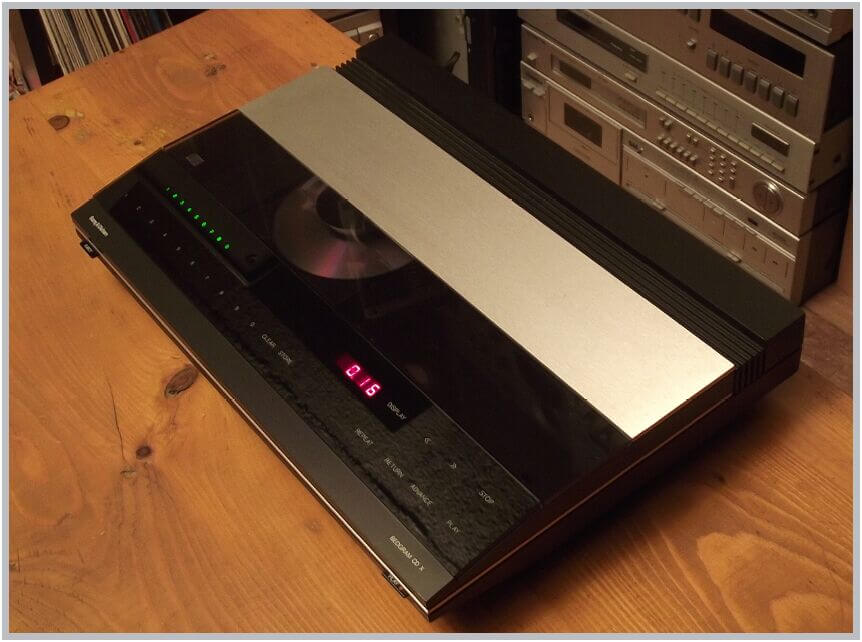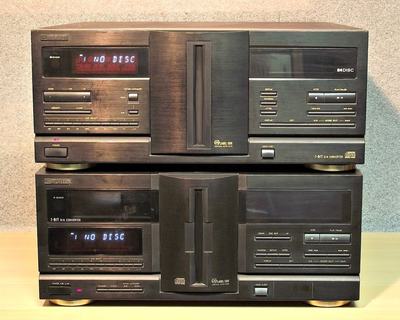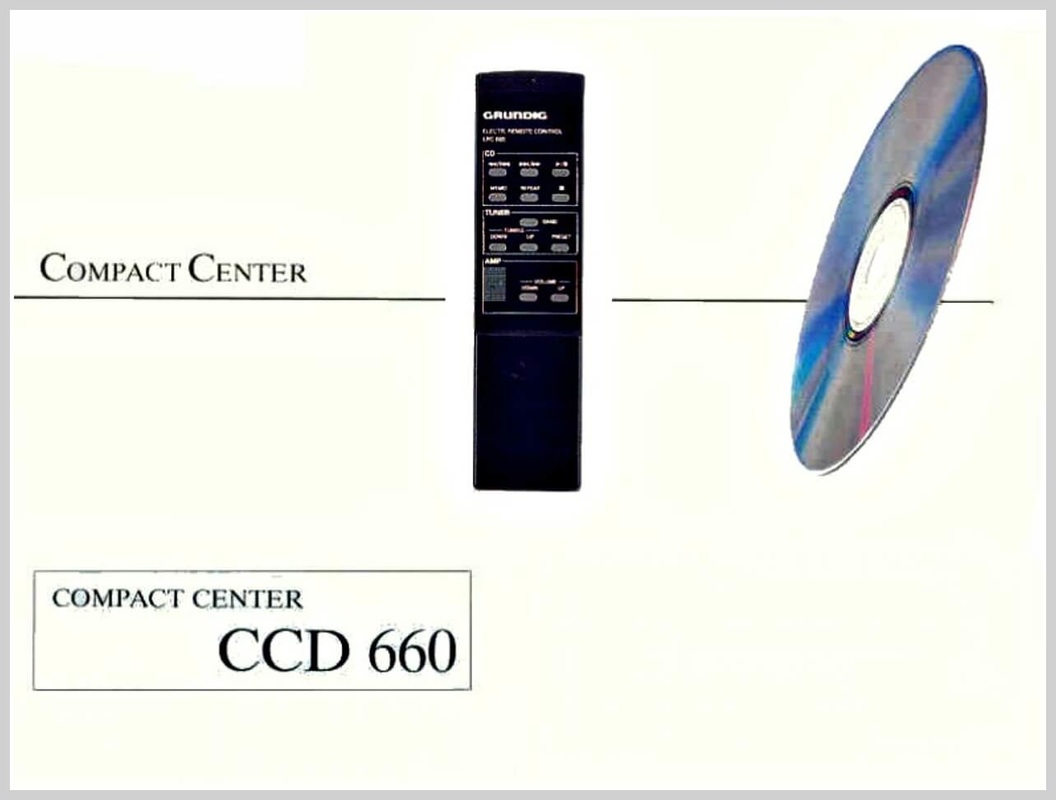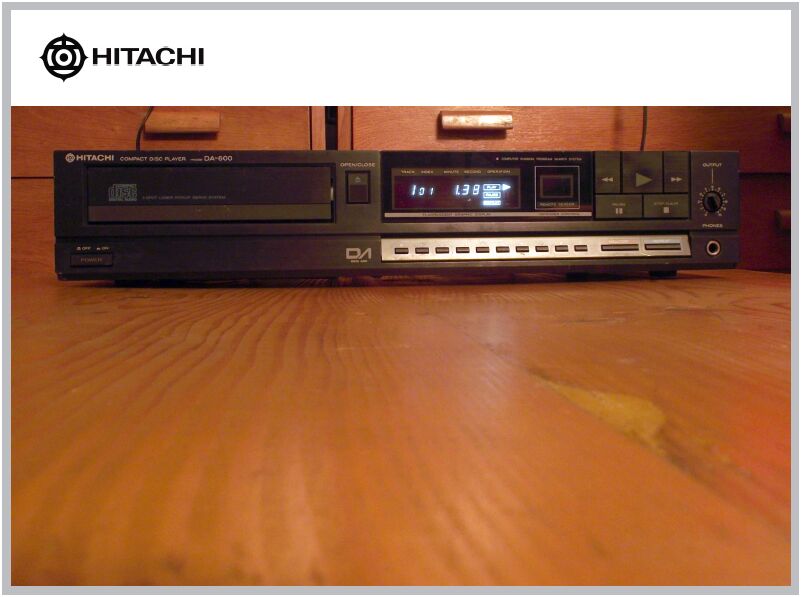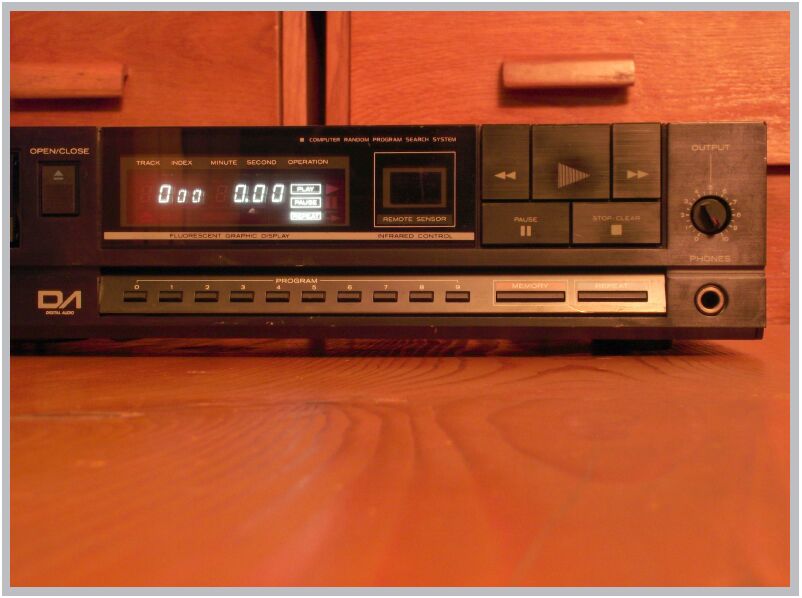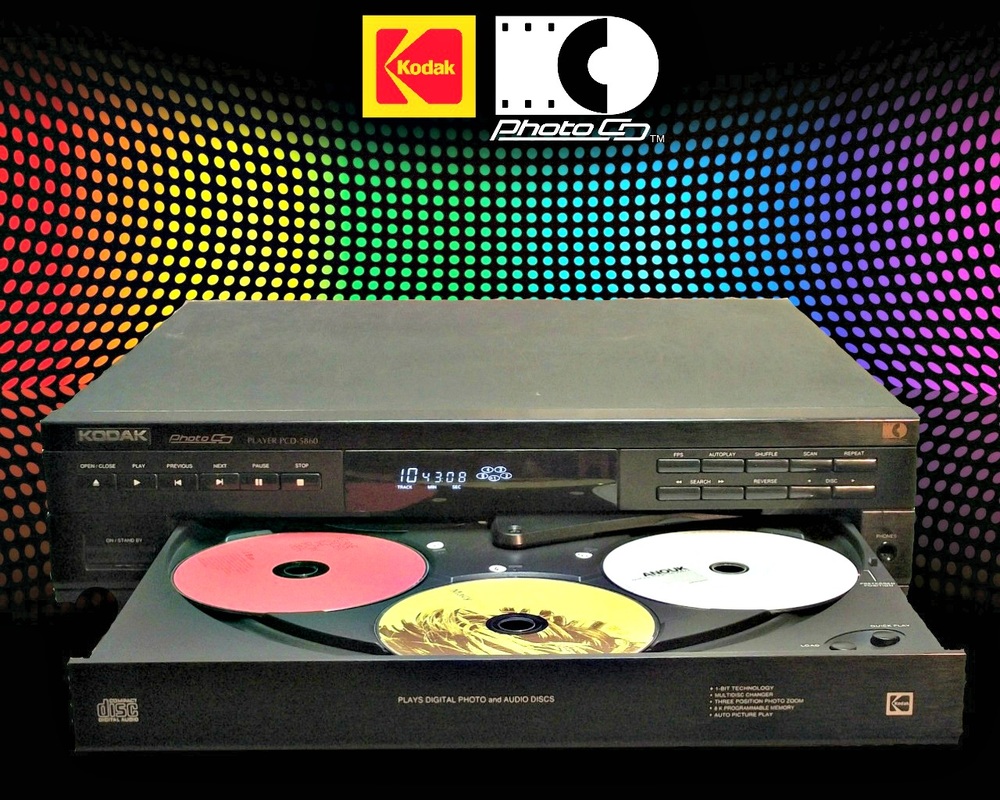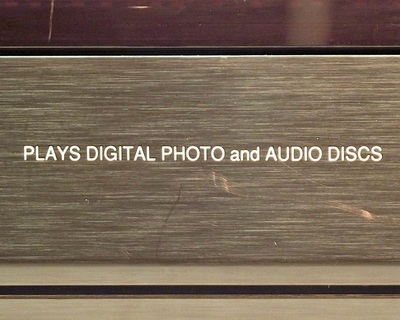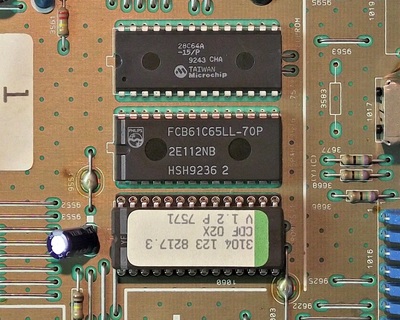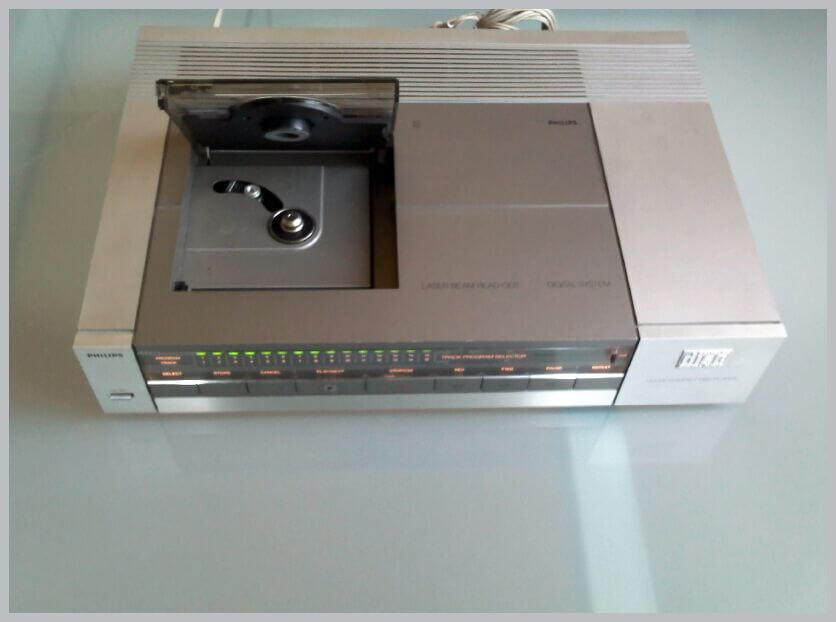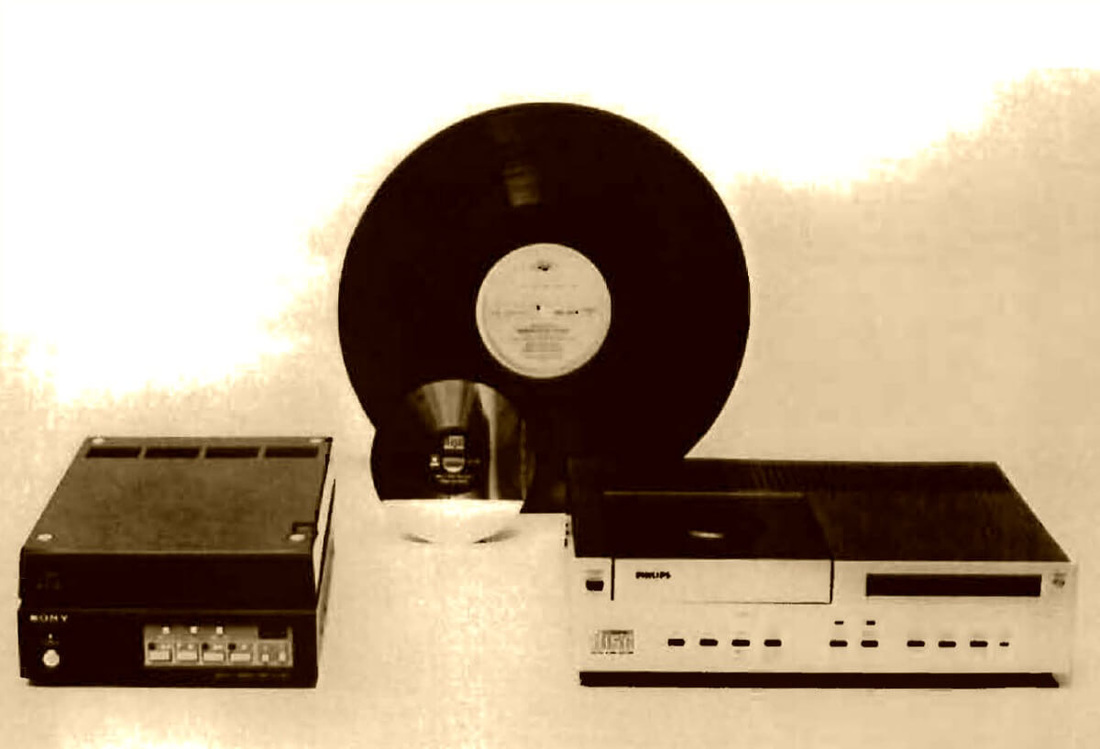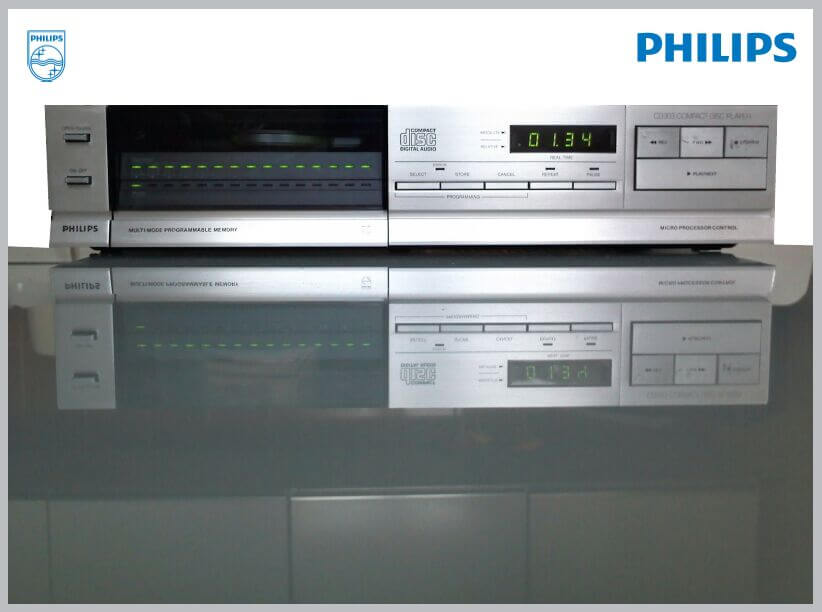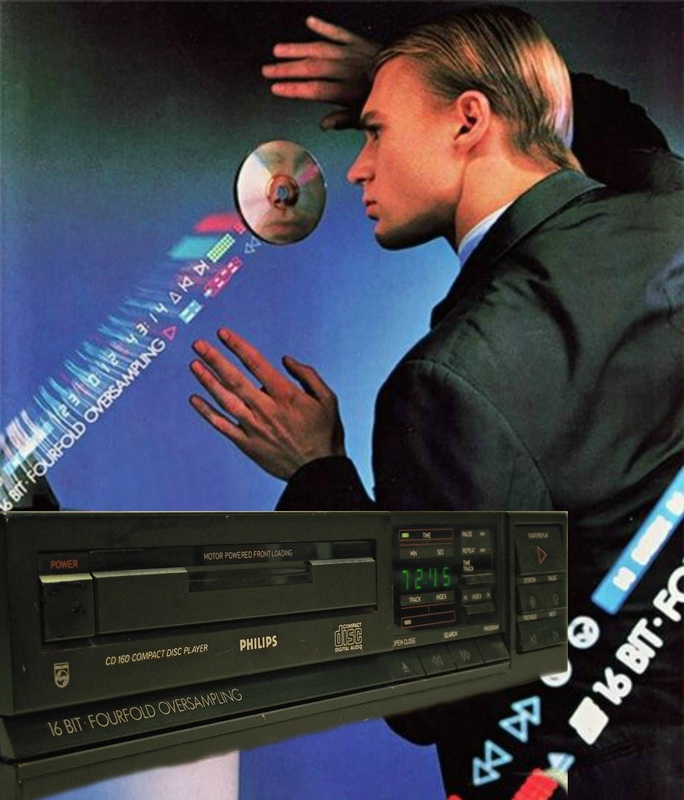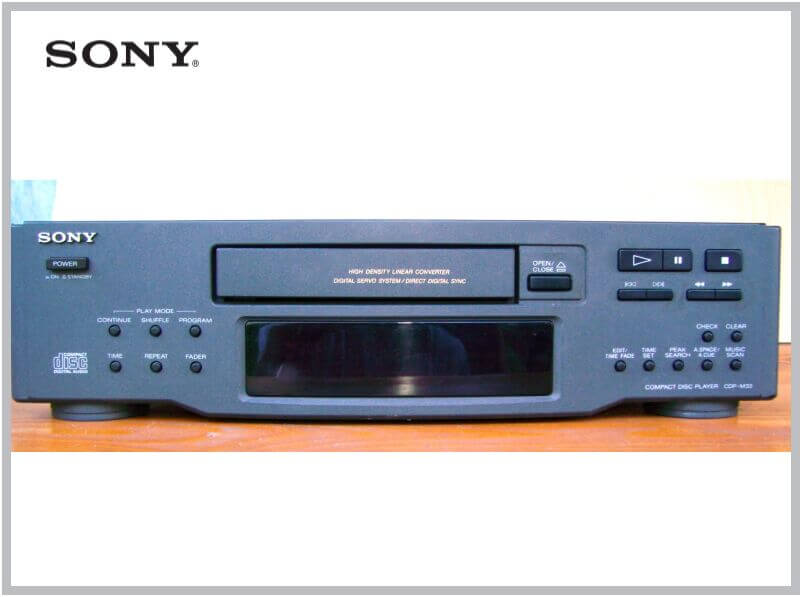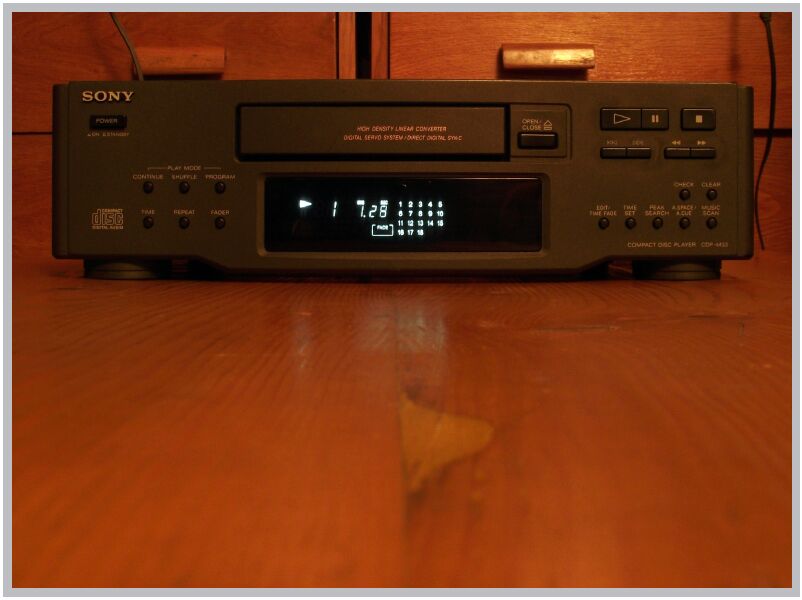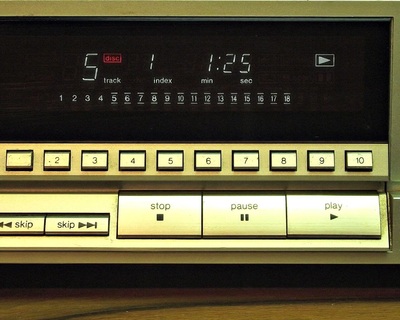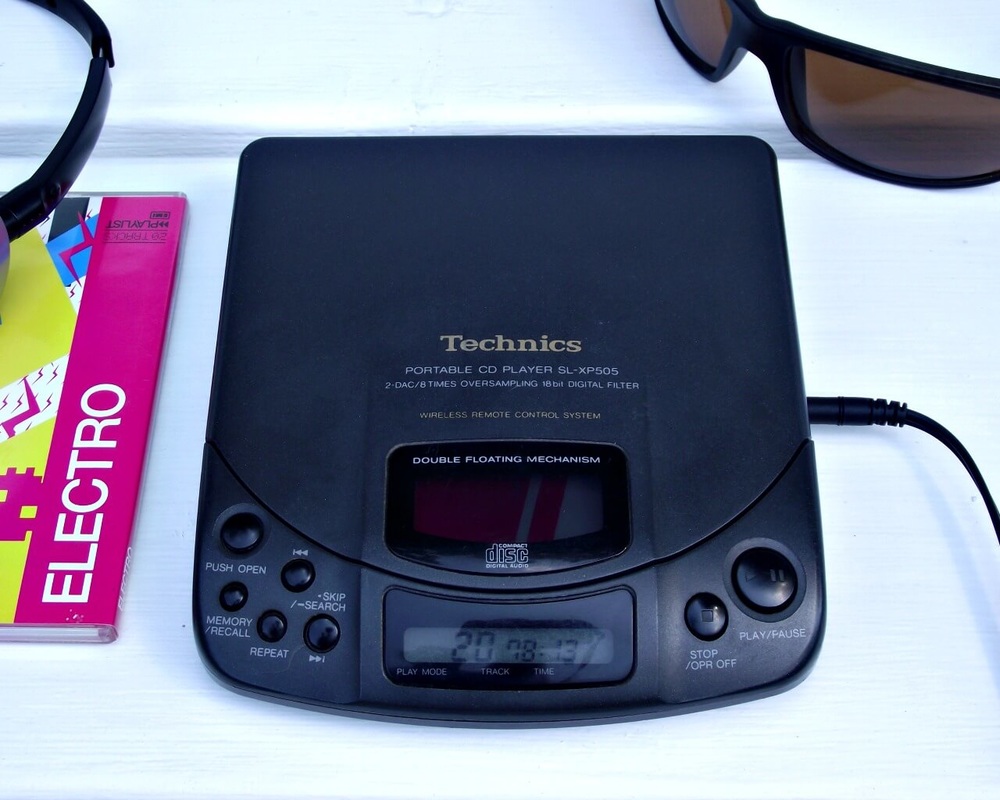AKAI CD-A30 (1986)
The AKAI CD-A30 is a CD player from the 1986 AKAI line-up, a second-generation CD player. It features simple operation with added random program and quick acces system, time display, but no remote or headphone output. The headphone output was added to the second version of this CD player while the black unit was also available with large anti-resonance special rubber feet. The front panel is plastic but the unit is still fully functional (...in 2013 ...in 2017). The subcode out is a feature that cannot be tested as this system never became operational. The idea was to send information that can be displayed on a screen, like disc info, player status etc.
Cover Photo Art: Heavy Duty - Last update April 23rd 2017
Cover Photo Art: Heavy Duty - Last update April 23rd 2017
AKAI CD-37 (1991)
The AKAI CD-37, the small model in the "Classic Series", was introduced in 1991 and it was available until 1993. Actually, the smallest model was the CD-27 but the CD-37 has added full function remote control. Unfortunately, some controls (programming, fast winding...) are only available on the remote itself. Classic Series in AKAI language means that this is a full-size model with aluminium front panel and a robust metallic housing construction. The player is built around a then popular SONY KSS-210A laser mechanism while the Digital to Analogue conversion is made by a Burr Brown converter, the PCM67P. This converter was called A.I.D.A. (Advanced Interpolative Dual D/A Converter) by the AKAI literature. All the usual information is displayed by a large display situated above the more or less centrally placed CD tray. Unfortunately, the time display is not what I would call extremely informative. This will only display Elapsed Track Time, Elapsed Disc Time (Total) and Remaining Disc Time (Total Remain). On the positive side the CD-37 has digital optical output and a front panel headphone output with dedicated amplifier and volume control. With the above-mentioned shortcomings this is basically a very nice overall CD player.
Cover Photo Art: Tracks to Remember - Published June 15th 2020
Cover Photo Art: Tracks to Remember - Published June 15th 2020
AKAI CD-M1200 (1998)
The AKAI CD-M1200 is the last genuine AKAI cd player that was already made in Korea as part of the AKAI 1998 line-up. Behind the black aluminium front panel there is an elevator-style 7-disc CD player that uses a Delta sigma 1 bit D/A converter and 8 times oversampling for the finest audio performance. The elevator-style CD changer is similar to the one that was used in the Nakamichi Music Bank system. That's no surprise as AKAI, Nakamichi and SANSUI were by this time, part of the same Grande Holding group. The unit can be remote controlled as a single unit with its own remote or it could be remote controlled in an AKAI system. There is a switch at the back to select single or system remote control. Besides the usual analog stereo output there is also a digital optical stereo output. Track skipping and programming of tracks is achieved via a large jog button on the front panel.
Cover Photo Art: Hungry Like a Wolf - Published February 15th 2015
Cover Photo Art: Hungry Like a Wolf - Published February 15th 2015
BANG & OLUFSEN BEOGRAM CD X (1985)
This beautiful cd player was designed by Jacob Jensen as the BEOGRAM CD X and was available from 1985 to 1988. It is a first-generation CD player using a 14-bit D/A converter that comes directly (with the CDM 1 drive) from the PHILIPS CD104. It is operated via a featherlight touch glass control panel. You simply touch the lettering on the glass panel to PLAY, STOP, Select track, etc. It has no dedicated remote control and can be connected to any amplifier like the BEOMASTER 2200 using the RCA plug cable that the unit is equipped with.
DENON DCD-800 (1987)
The DCD-800 is part of the 1987 model range of CD players from Denon. It uses a D/A converter from Burr-Brown called by Denon a "W super linear converter". It uses a four times oversampling digital filter while the laser pickup employs a 3-beam optical head in a fully floating transport. On its low-profile aluminium front, we can find a full array of controls complete with a 10-key direct track access pad. A large-sized fully featured bright and clear fluorescent display will show all the necessary information and it even has a separate index display. On the lower right corner there is a headphone socket with volume control. The CD player has a dedicated remote control with volume control for the separate variable output found at the back of the unit next to a fixed level line-out. The amount of reduction from the maximum volume is displayed in the second part of the display for approximately 2 seconds. When the power is turned on, the value is displayed as -20 and is set to approximately 1/30. Technical data: Dynamic range 95db | Signal-to-noise 99dB | Total harmonic distortion 0.004% | Dimensions 434x99x315mm (W/H/D) | Weight 4.1kg.
Cover Photo Art: Spinning a Disc - Updated May 17th 2023
Cover Photo Art: Spinning a Disc - Updated May 17th 2023
DENON DCD-890 (1992)
The DCD-890 was part of the top-class CD players from Denon, equipped with the "Real 20bit Lambda Super-Linear-Converter" that promised "beautifully transparent sound with precise and totally stable localization and ear-opening clarity". Inside the DCD-890 we will find two Burr-Brown PCM61P digital-to-analog converters (...18bit) while the Laser assembly is the KSS-240A from Sony. All this in a Japanese CD player Made in... Germany. The aluminum front panel is simple and elegant with well laid out controls that include separate track skip and fast winding controls, direct track access through ten-key pad and a series of programming, time editing, peak search functions. There is also a fader button (fade in-out), remote controlled volume level and a display dimmer to adjust brightness or to turn off the display completely. The display itself is clear, legible and bright. On the front panel there is also a headphone socket with volume control. On the back panel we can find a fixed level RCA line output, Digital coaxial out and a synchro socket for remote control signals from a Denon amplifiers remote. Optional side panels were also available. Technical data: Dynamic range 98 dB | Signal-to-noise 107 dB | Distortion 0.003% | Dimensions 434x120x288mm (W/H/D) | Weight 4.2 kg.
Cover Photo Art: Für Elise - Published May 15th 2023
Cover Photo Art: Für Elise - Published May 15th 2023
FISHER DAC-2415 (1995)
Compact disc changers were extremely popular since their introduction. The first changers used removable magazines holding six to ten discs while the next step was the introduction of the home carousel changer, holding up to six discs on a rotating platform that turns to place a disc on the playing spindle.
The FISHER Studio 24’s mechanism incorporates a nonremovable rotating magazine with slots for twenty-four standard-size CD. The discs are loaded, one at a time, through a vertical slot in the front panel that is normally closed but opens at the touch of a button. The Studio 24 also offers a means of classifying the discs and displaying this information on the aplhanumeric display. It has seven built-in music categories, designated as Rock, C/W (country-and- western). R (rhythm-and-blues), Jazz, Easy (easy-listening), Show (show tunes), and Clas (classical). The appropriate designation can be assigned to each CD loaded in a magazine slot and will then appear in the display when the disc in that slot is selected for playing. You can also create and store your own category names of up to eight characters. In addition, an eight-character subcategory name can be assigned to each slot and stored; like the main category, it is displayed when that slot is selected. There were several versions of this type of CD player and we also have a previous model, the DAC-9336 advertised by Alice Cooper....and his mom. This type of CD Changer was originally created by SANYO and sold mostly under the FISHER brand name but you can also find them as OPTIMUS by Radio Shack.
A video of this CD player can be seen here.
Published February 15th 2017
A video of this CD player can be seen here.
Published February 15th 2017
GRUNDIG CD 301 (1991)
Nice player with PHILIPS CDM 4/19 - CD mechanism. It is equipped with a 16-bit D/A converter with 4 times oversampling. It has a nice display and a headphone output with volume control. It can be remote controlled in a GRUNDIG or PHILIPS (MARANTZ) system via RC 5 system remote control jack. This player was "Spitzenklasse" (Top class) in the German Audio 4/91 magazine.
GRUNDIG CD-660 (1992)
Midi sized player, mini display, basic functions. It is equipped with a 16-bit D/A converter with 2 times oversampling. As part of a midi system can be remote controlled.
HITACHI DA-600 (1984)
Second generation of CD players from one of the leaders in CD player manufacturing. The player had an infrared remote control, headphone output with volume control, direct acces to track via numerical keypad on the player and the remote. The laser is a "3 spot laser pickup servo system" and the programming was a "computer random program search system". This player was Made in Japan (= made to last).
JVC XL-V311 (1989)
The XL-V311BK (BK is for black model) was introduced by JVC with its' 1989 model range of CD players. It belongs to their "mid range" CD players and it features a "Dual 18-bit noise shaping DAC" with no crossover distortion and clear imaging. A 4-times oversampling digital filter is used for more accurate response. In order to guarantee this high level of precision the XL-V311 is using a high-precision 3-beam laser pickup...and for even more precision it adds a Disc stabilizing clamper. Even though I see no difference between a regular CD clamping system and this "Disc stabilizing clamper" the XL-V311 performs extremely well, both sonically and in disc reading time. Don't let yourself be fooled by the fact that the whole front panel is made of plastic, all the rest of the components show a high build quality and precision for this price point. Solid overall. The XL-V311 was factory delivered with a dedicated infra-red remote control, the RM-SX311U. While we don't have this dedicated remote control unit in our collection, we do have a system remote control from the AX-R551 amplifier that can directly control the basic functions of the XL-V311. The CD player also features a long list of editing function that can be used to copy a CD to a tape recorder. Its' large and clear amber coloured display will give you all the information you need, a true full function display. For private listening sessions there is a front panel headphone socket which although it has no volume control it offers a comfortable listening level. Dimensions: 435x92x290mm | Weight: 3,6kg.
Cover Photo Art: Noise Shaping - Published January 15th 2024
Cover Photo Art: Noise Shaping - Published January 15th 2024
KENWOOD DP-2050 (1993)
The DP-2050 was a new model in the 1993 Kenwood cd player lineup. It shares the same construction with the entry level DP-1050 with added remote control capability. Even though the front panel is made of plastic with simulated brushed aluminium finish overall, it's a solid player. It is based on the Sony KSS-240A CD mechanism and features 1-Bit D/A converter with 3rd order noise shaping. The disc tray is centrally mounted above the full function VFD display while the controls are on the right side of the front panel. With the Time Display button, you can switch between all-time display modes: Elapsed time of the track being played - Remaining time of the track being played - Elapsed time of the whole CD - Remaining time of the whole CD. Up to 20 tunes can be programmed using the front panel numeric keypad or using the numeric keypad on the remote control. This model features two different Line Output, one with fixed level and one with variable level. The output level can only be adjusted over the remote control (the U.S.A. model has no variable output). The CD player also features the Kenwood XS System Control. When connected to an amplifier or receiver having XS terminals, system operation is possible with the remote control of the amplifier. By connecting the XS System Control terminal with a Kenwood cassette deck, CCRS recording can be carried out. The CCRS function is used when recording from a CD to a tape in a cassette deck, and operates to adjust the cassette deck's recording level to the optimum setting according to the playing level of the CD. Dimensions: 440*107*261 mm | Weight: 3,3 kg.
Cover Photo Art: Give a Little Bit - Published March 15th 2021.
Cover Photo Art: Give a Little Bit - Published March 15th 2021.
KODAK PCD-5860 (1992)
Disco King or Photo album? Well, it's a little bit of both as the KODAK PCD-5860 is a 5-disc carousel CD player that can also be used to visualize digital photos on your TV set from a Photo CD. The KODAK Photo CD is a standard for digital photo archiving using as medium a CD disc. It was co-developed by Eastman Kodak Company and PHILIPS with first products launched in 1992. This CD player was made in Belgium where also PHILIPS products were built. It can be connected to a TV set via different AV connectors to display pictures from a Photo CD or a simple content list when you load audio CD. I have no Photo CD to test these functions and it will not display .jpg photos from a recordable CD. On the other it can still act as the Disco King as audio CDs can be played with no problem at all.
Cover Photo Art: Disco Spinner - Published April 15th 2016
Cover Photo Art: Disco Spinner - Published April 15th 2016
ONKYO DX-7210 (1995)
Big player with a big informative display and all the editing functions. Not too many components inside, but that was a time when manufacturers made their players to visually match the amplifier that you will use. And those amplifiers were big. Here are some technical details: Fine Pulse Conversion System, 1 Bit D/A converter and AccuPulse-Quartzsystem, R1 remote control (the Onkyo system remote)
PHILIPS CD 202 (1983)
The EVERLASTING. First generation player equipped with the famous PHILIPS CDM-0 drive unit. It is a player in perfect working order. This model replaced the CD200, the difference being that CD202 has an added time counter. The time counter only works (it lights up) when the CD is in PLAY mode, or fast winding. You can also find this model as LOEWE CD 9000 - a rebadge.
30 YEARS OF CD (1982-2012)
In 2012 we have celebrated the first 30 years of the CD. According to documents of time on October 1st 1982 the world first CD players were announced in Japan. Some consider this as the date of launch of CD technology, while other consider the birth date of CD, the world wide launch in 1983. Regardless of these views there are a few facts you should know about CD:
- Based on the previous Audio Long Play project, in 1974 PHILIPS launched a project for a 20 cm disc for music on an optical disc, using Laser technology
- In 1977 PHILIPS adopted the "Compact Disc" name for this format, and suggesting a disc with an 11.5 cm diameter (the diagonal measurement of a "Compact Cassette" - a successful PHILIPS format)
- SONY engineers presented an optical audio format in September 1976, and by 1978 a 150 minutes disc
- The 44.1kHz oversampling frequency was the result of available technology of the time. That available technology was the SONY U-matic video tape. With the use of a PCM (pulse code modulation) adaptor resulted an audio recording with 44.1 samples per second on a PAL cassette. For a usable frequency response of 20-20.000 Hz you need at least the double of 20kHz (20.000 Hz) samples per second.
- This system could store 16-bit samples with error correction, or could store 14-bit with no correction at a 44 khz sampling rate.
- Before official launch PHILIPS engineers already had a 14-bit digital to analogue converter with 44kHz sampling rate, while SONY was promoting a 16-bit system with 44.1kHz oversampling.
- PHILIPS and SONY teamed up and decided that the "Red Book" standard for CD should be 16bit with 44.1kHz oversampling on a 12 cm disc (the diameter required to store a 74 minutes recording of Beethoven's 9th Symphony from the PHILPS / Polygram catalogue)
PHILIPS CD 303 (1983)
The other EVERLASTING. First generation player equipped with the famous PHILIPS CDM-0 drive unit. This was the flagship model in 1983. The PHILIPS CD 303 was available together with CD 101 and CD 202 models, which can be considered the "MK II" versions of the first-generation CD players. Just like model CD 202 replaced the CD 200, the CD 303 replaced the previous CD 300 with the added time counter. On this model too, the time counter works (it lights up) only when the CD is in play mode. The equivalent model from MARANTZ was the CD 73, with a modified front panel design. Another rebadge was the GRUNDIG CD 7500.
PHILIPS CD160 (1986)
Introduced in 1986 the PHILIPS CD 160 was a midi sized CD player using the newly developed 16-bit DAC, the TDA1541. (The one used in this unit was manufactured in 1986, week 31 in Holland) The mechanism used for this player was the PHILIPS CDM-2/10, a lightweight version of the famous PHILIPS swingarm mechanism. All the functions are available on the front panel complemented by a basic but easy to read green LED display. The CD player can be remote controlled by the PHILIPS EM 2000 remote accessory. This system is comprised of a pyramid shaped receiver that connects to the back of the unit and the usual handheld unit. The PHILIPS CD 160 was sold as a standalone unit but its design was made to match the design of the PHILIPS FS 363 midi system (also part of the 1001 Hi-Fi collection)
Cover Photo Art: Digital Magik - Published May 15th 2016
Cover Photo Art: Digital Magik - Published May 15th 2016
PHILIPS CD 380 (1988)
The CD 380 was introduced by Philips in 1988. It is 36cm wide midi sized player specially made to match the design of the F880/883/885 midi systems. When used with these systems the CD player can be remote controlled via the main system to which is connected using a RC-5 remote cable. This is a 16 Bit D/A converter player and it uses a CDM-4/19 CD mechanism, the same mechanism that you will find in highly regarded and expensive players. This is a swing-arm mechanism that is secured in place during transportation by the two red bolts (see underside photo) that are now placed in their storage place. In contrast with other players from this series that use fluorescent display this model is equipped with a simpler LED display. The only problem with this solution is that you cannot display simultaneously track number and track time, you have to switch between the two modes, track-time. On the positive side however, this model has separate track skip and search keys. Another interesting feature is the "auto-play". This means the player will spin up and play a pre-loaded CD the moment power is turned on. The front is clearly arranged and there is even a headphone socket on the front. Dimensions: 360x80x300 mm | Weight: 3.5kg.
Cover Photo Art: Digital Inside - Published April 13th 2023
Cover Photo Art: Digital Inside - Published April 13th 2023
PIONEER PD-S701 (1992)
Great CD player with stable platter mechanism. One of the greatest ideas to improve disc stability was the stable platter mechanism made by PIONEER. This was used by many high-end CD player manufacturers. In this player the CD has to be put label side down (upside down) to play. This is also good, as no dust can accumulate on the laser lens (it is upside down, reading from above). Some of the technical highlights of this player are: High Speed 1 bit D/A converter, stable platter mechanism, optical digital stereo output, display off, headphone with remote controlled motorized volume, two analog outputs - one with fixed level and one with variable level (remote controlled output level) One common problem with these players is the fact that the lens could fall out. If the lens is loose inside your player see how it has to be placed back following this link. Unfortunately, there is another design flaw with this player. If it is left for a long time in stand-by mode the display will completely fade out.
PIONEER PD-M701 (1992)
Multi CD player for 6 CD's. The CD compartiment can be completely ejected and moved to a car CD player. You have to read carefully the instructions on the CD compartiment to see how to insert discs in the changer cartridge. The converter used was a "pulseflow" type 1bit D/A converter. It has a remote control, CD-DECK synchro for easy, one touch copy from CD to TAPE (only with PIONEER cassette tape recorders). If there were sound level differences between CD's in the cartridge there was an "ADLC" (automatic digital level control) cicuit to compensate this.
SONY CDP-M33 (1992)
Similar features and technology as for the full-sized players. The High-Density Linear Converter was the SONY way for a 1-bit D /A converter. This player was part of a midi style system. If you are a person who is making compilations from CD's a handy feature is the fade in and out function.
SONY CDP-390 (1989)
Basic player with remote control and headphone output with volume control for private listening sessions. It uses a dual D/A converter system with 4 times oversampling digital filter and a servo stabilizer circuit. One handy feature for recording enthusiasts is the fade in/out function.
SONY CDP-791 (1991)
Upper class CD player. All the functions that you ever needed ......or not. I remember that once I counted how many models SONY had. There were 16 models in their 1991 catalogue, but they were in fact 4 basic models with different extra functions.
Technics SL-P470 (1990)
Introduced in 1990 the Technics SL-P470 was among the first cd players that used the MASH (multi stage noise shaping) 1 bit D/A converter developed by Nippon Telegraph and Telephone. To be more accurate it is the MN6474 MASH D/A converter that was used in combination with the SOAD70A linear motor CD mechanism (see detail picture). This unit was available in both black and silver (both plastic) the black being the more common color you'll find. Besides the usual programing function, it has a tape edit function that helps you to create an optimal selection of tracks that best fits your compact cassette. For quick music search there is a large variable speed search wheel. The display is very nice, large, easy to read and I find the keyboard layout as the most ergonomically ever designed. Many consider the MASH D/A equipped cd players as very good sounding and this unit is no exception, just press play and enjoy your favorite cd.
Published August 15th 2015
Published August 15th 2015
TECHNICS SL-P377A (1990)
Technics usually built their components in-house but for the SL-P377A from 1990 they decided to use a PHILIPS CDM 4/19 laser mechanism to partner their recently introduced MASH 1 bit digital-to-analog converter (originally by NTT). This might look like a surprising decision but if you read the history page of Panasonic (Matsushita, Technics) you will discover that PHILIPS was the company that actually helped Matsushita (today Panasonic) at the beginning of their activity. In return Philips later became a supporter of the SD memory card format, a Panasonic format. The CD player itself is a prime example of ergonomic design. All the controls are in the right place, the display is large, clear, bright and all the necessary information is displayed in a clear manner. Editing functions are included in order to easily fit tracks to be recorded from a CD to various cassette lengths. You can switch between various time display modes or select an index (mostly found on classical music CDs) of a disc from the remote. Overall, a solid performer, still working well in 2019.
Cover Photo Art: Silver Spinner - Updated 11th November 2019.
Cover Photo Art: Silver Spinner - Updated 11th November 2019.
Technics SL-XP505 (1992)
The Technics SL-XP505 portable CD player was introduced in 1992. It features a double floating mechanism and is equipped with 16 bit 2 DAC/8 times oversampling 18bit Digital filter. The original earbud had integrated remote control but there was also available an infrared remote system comprised of a receiver and the handheld unit. Unfortunately, I don't have these components but the unit can be successfully used with any headphone equipped with a 3.5mm jack. This is a (AA) battery operated portable unit but with an AC adaptor it can be transformed into a standalone unit. When the unit is powered by the AC adaptor the STOP and PLAY buttons will illuminate and the backlight of the display will be turned on. The unit is equipped with a dedicated line output for optimal performance when used connected to an amplifier.
Cover Photo Art: Electro_Motion - Published 15th July 2016
Cover Photo Art: Electro_Motion - Published 15th July 2016
YAMAHA CDX-580 (1994)
Following a long series of successful audio products this is a cd player from the 1994 YAMAHA model range. A great CD player with PRO-BIT technology, consisting of an "S-Bit Plus" DAC (22 Bit) and 8fs Digital filter. It has a remote-controlled digital volume control for headphone and output and a dimmable display in 3 steps (step 3 is off). The orange (amber) display is a nice touch too.





